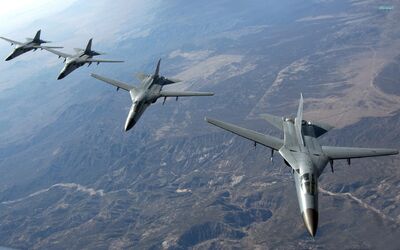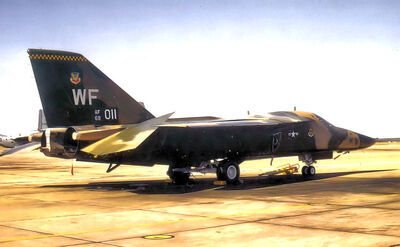
General Dynamics F-111[]
The General Dynamics F-111 "Aardvark" was a medium-range interdictor and tactical strike aircraft that also filled the roles of strategic bomber, reconnaissance, and electronic warfare in its various versions. Developed in the 1960s by General Dynamics, it first entered service in 1967 with the United States Air Force. The Royal Australian Air Force (RAAF) also ordered the type and began operating F-111Cs in 1973.
The F-111 pioneered several technologies for production aircraft, including variable-sweep wings, afterburning turbofan engines, and automated terrain-following radar for low-level, high-speed flight. Its design influenced later variable-sweep wing aircraft, and some of its advanced features have since become commonplace. During its initial development, the F-111 suffered a variety of problems, and several of its intended roles, such as naval interception, with the F-111B, failed to materialize.
USAF F-111 variants were retired in the 1990s, with the F-111Fs in 1996 and EF-111s in 1998. In USAF service, the F-111 has been replaced by the F-15E Strike Eagle for medium-range precision strike missions, while the supersonic bomber role has been assumed by the B-1B Lancer. The RAAF was the last operator of the F-111, with its aircraft serving until December 2010.
General Dynamics F-111A[]

The F-111A was the initial production version of the F-111. Early A-models used the TF30-P-1 engine. Most A-models used the TF30-P-3 engine with 12,000 lbf (53 kN) dry and 18,500 lbf (82 kN) afterburning thrust and "Triple Plow I" variable intakes, providing a maximum speed of Mach 2.3 (1,450 mph, 2,300 km/h) at altitude. The variant had a maximum takeoff weight of 92,500 lb (42,000 kg) and an empty weight of 45,200 lb (20,500 kg). The A-model's Mark I avionics suite included the General Electric AN/APQ-113 attack radar mated to a separate Texas Instruments AN/APQ-110 terrain-following radar lower in the nose and a Litton AJQ-20 inertial navigation and nav/attack system. The terrain-following radar (TFR) was integrated into the automatic flight control system, allowing for "hands-off" flight at high speeds and low levels (down to 200 ft).
- Tech Level: 5
- Damage Base: 26
- Min./Max. Airspeed: 3/25
- Maneuver (Loaded): 6 (8)
- Aerobatic (Loaded): -2 (-4)
- Defence (Loaded): 13 (12)
- Climb Rate (Loaded): 1 (0.8)
- Shallow/Steep/Power/Vertical Dives: 2/4/6/8
- Operational Ceiling: 10
- Stores External/Pylon/Internal: 13/0/0
- Guns: None
- Cost: 1163
- Maintenance Cost: 116
General Dynamics F-111C/FB[]

The F-111C is the export version for Australia, combining the F-111A with longer F-111B wings and strengthened FB-111A landing gear. Australia ordered 24 F-111s and, following delays, the Royal Australian Air Force accepted the aircraft in 1973. Four were converted to the RF-111C reconnaissance variant in 1979-80. Australia also purchased four ex-USAF F-111As and converted them to C standard. F-111C aircraft received avionics, weapons system and other upgrades during their time in service. The RAAF retired its last F-111Cs in December 2010.
General Dynamics F-111D/E[]

The F-111D was an upgraded F-111A equipped with newer Mark II avionics, more powerful engines, improved intake geometry, and an early glass cockpit. The variant was first ordered in 1967 and delivered from 1970-73. The F-111D reached initial operational capability in 1972. Deliveries were delayed due to avionics issues. 96 F-111Ds were built. The sole operator of this variant was the 27th TFW stationed at Cannon AFB, New Mexico.
The F-111D used the new Triple Plow II intakes, which were located four inches (100 mm) further away from the airframe to prevent engine ingestion of the sluggish boundary layer air that was known to cause stalls in the TF30 turbofans. It had more powerful TF30-P-9 engines with 12,000 lbf (53 kN) dry and 18,500 lbf (82 kN) afterburning thrust.
General Dynamics F-111F[]

The F-111F was the final F-111 variant produced for Tactical Air Command, with a modern, but less expensive, Mark IIB avionics system. The USAF approved development of the variant in 1969. It also included the more powerful TF30-P-100 engine and strengthened wing carry through box. 106 were produced between 1970 and 1976.
General Dynamics EF-111 Raven[]

To replace the aging Douglas EB-66, the USAF contracted with Grumman in 1972 to convert 42 existing F-111As into electronic warfare aircraft. The EF-111A can be distinguished from the F-111A by the equipment bulge atop their tails. In May 1998, the USAF withdrew the final EF-111As from service, placing them in storage at Aerospace Maintenance and Regeneration Center (AMARC).
Voodoo Scuttlebutt[]